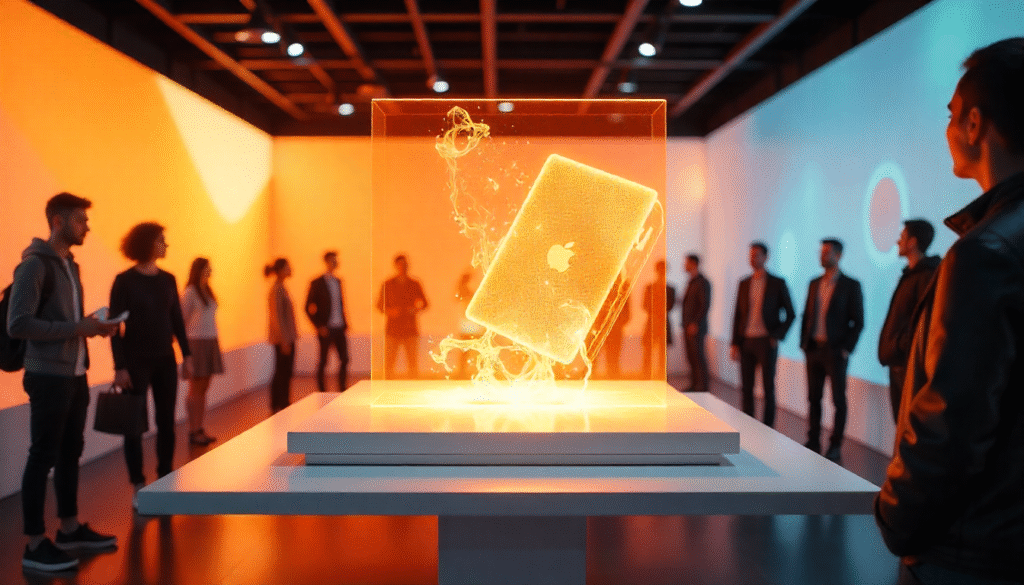
Apple has long been synonymous with innovation, consistently setting benchmarks in design, usability, and consumer experience. From the iPhone’s multi-touch revolution to the Apple Watch redefining wearables, the company has proven its ability to foresee and shape market trends. The next frontier? Holographic displays. This emerging technology could be Apple’s boldest step yet, merging futuristic design with practical utility to captivate users and redefine interaction with devices.
1. The Current State of Display Technology
Display technology has evolved rapidly over the past two decades:
- LCD to OLED brought richer colors and energy efficiency.
- Retina displays introduced unmatched pixel density.
- ProMotion technology enhanced smoothness with high refresh rates.
Yet, even with these advancements, today’s displays remain two-dimensional. Holographic technology offers the opportunity to transcend flat screens, creating immersive, 3D visuals without the need for glasses or external devices. This evolution would align perfectly with Apple’s design ethos: minimalism combined with maximum impact.
2. Why Holographic Displays Align With Apple’s Ecosystem
Apple’s ecosystem thrives on integration and user experience. A holographic interface could:
- Transform FaceTime calls into lifelike conversations.
- Enable 3D previews in AR apps, enhancing design, shopping, and learning.
- Elevate entertainment experiences, from movies to gaming.
- Support professional workflows by allowing 3D modeling and medical visualization.
Given Apple’s massive investment in augmented reality and mixed reality, holographic displays would be the logical next step to unify hardware and software in a more immersive ecosystem.
3. Market Trends and Competitive Edge
The tech industry is buzzing about extended reality (XR) and spatial computing. While competitors like Meta and Samsung are experimenting with AR/VR solutions, none have perfected seamless holographic displays. Apple’s advantage lies in its track record: it doesn’t rush to market first—it arrives later but redefines the category.
For readers tracking Apple’s innovation timeline, the latest Apple news updates by Apfel Patient offer a reliable source of insights into upcoming technologies. This contextual backdrop makes it clear that holographic displays could be Apple’s ace card in the competitive race.
4. Use Cases: Beyond Entertainment
Holographic displays extend far beyond cinematic wow factors. Potential applications include:
- Healthcare: Surgeons could practice operations with 3D patient models.
- Education: Students could interact with holographic elements, making learning more engaging.
- Retail: Customers could view holographic product previews before purchase.
- Wearables Integration: Paired with Apple Watch or AirPods, holographic technology could enrich spatial notifications and controls.
Such versatility would position Apple not just as a device maker but as a holistic lifestyle brand with solutions spanning leisure, productivity, and wellness.
5. The Luxury Dimension of Holographic Experiences
Apple has always understood the balance between cutting-edge tech and aspirational design. Just as the Apple Watch transformed from a fitness tracker into a status symbol, holographic displays could carry a similar premium appeal.
The integration of holographic elements into wearables, iPhones, or even eyewear could align with broader trends in Luxurious Wearables Sensible Vogue—where style meets smart technology. Consumers increasingly expect devices to be as fashionable as they are functional, and holographic displays would push this convergence even further.
6. Technical and Ethical Challenges Ahead
Despite its promise, holographic technology isn’t without obstacles:
- Hardware limitations: Compact, efficient projectors need refinement.
- Battery life: Rendering complex 3D visuals is energy-intensive.
- Accessibility: Premium pricing could limit adoption.
- Content ecosystem: Developers must create apps and media optimized for holographic interfaces.
Apple’s long-standing focus on efficiency, user privacy, and accessibility suggests it will address these hurdles thoughtfully, ensuring holographic displays are not just flashy gimmicks but transformative tools.
7. The Bigger Picture: Apple and the Future of Interaction
Apple’s push toward spatial computing signals a fundamental shift in how humans interact with technology. Holographic displays could eventually replace traditional screens, offering experiences that are immersive, intuitive, and human-centric.
Whether for collaboration, creativity, or communication, Apple’s move toward holographic innovation would not just enhance its product lineup but also shape the future of digital interaction as we know it.
Conclusion
Holographic displays are no longer science fiction—they are on the horizon, ready to transform everyday life. If Apple embraces this technology, it could spark a paradigm shift in consumer electronics, much like the iPhone did over a decade ago. With its design prowess, ecosystem advantage, and cultural influence, Apple has the potential to make holographic displays mainstream and indispensable.